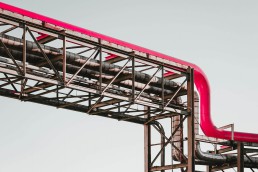Digital innovation empowers water companies
In an article published in The Times Raconteur, Edem Eno-Amooquaye discusses how digital innovation is empowering water companies to be more proactive, strategic and efficient in how they deal with property developments.
This article is based on a project with Anglian Water that has had a dramatic impact on customer service and efficiency in Developer Services.
Water companies are looking to harness emerging automation technology and smart data to transform their services. Often this requires a new way of working, closely focused on defined business outcomes, effective digital innovation and proper collaboration.
Among them is Anglian Water, which has established close working relationships with a small group of expert companies to digitally transform its developer services business. This transformation will deliver process efficiencies and more than £20 million of savings over the next five years.
Ian Amis, Head of Developer Services at Anglian Water explains:
“Historically, our customers would come to us and say ‘we have a development and we need water infrastructure’ and then we would come up with a solution. With our project we will have visibility much earlier, when engaging with property developers is still just a thought for landowners wanting to sell, enabling us to be more proactive, strategic and efficient”
The systems fully digitise the application process, planning and asset delivery. They also provide advanced geospatial capabilities that include drawing polygons for developer services applications – the first such programme in a UK water utility – and offer automated workflow management. In contrast, many other utilities only digitise or outsource application submission and assessment, and some have no digital capability at all in their developer services businesses.
The success of the project in meeting measured strategic outcomes means its application has been carefully broadened. “We began with a focus on low-volume, high-complexity schemes, but realised these platforms will work for all our one-off customers, our builders and our big developers as well,” says Mr Amis. He describes the work as “totally transformational” because the water company is able to provide developers with much better experiences and is ready to meet the customer service requirements of Ofwat’s new AMP7 DMeX measure.
“Grosight and Inflow are equipping Anglian Water with the capability to take a strategic approach to asset planning across the entirety of a water resource zone and recycling catchment area, reducing design costs by identifying site clusters and efficient solutions,”
explains Curzon managing consultant Edem Eno-Amooquaye.
Better site visibility provides greater insight on the needs of property developers, enabling sustainability initiatives such as water reuse to be encouraged and cutting the cost of late changes.
During the project, collaboration between business functions, IT and delivery teams has been essential. As guardian of the business case, Curzon Consulting has orchestrated this collaboration and taken responsibility for grounding all technical requirements and design functionality in the reality of business benefits.
“Curzon Consulting has led in defining the change management strategy to ensure the benefits of digitisation and new ways of working are embedded within the developer services business”
explains Edem.
This critical role has served to provide assurance to both Anglian Water and the IT team throughout the life cycle of the programme.
To make the relationship work between separate companies, in such a crucial commercial context for Anglian Water, all the parties have focused on growing together. The process has proved to be highly efficient and open, with the customer at its heart.
Our work with Anglian Water on digital innovation has won several awards such as Innovation Consultant of the Year and Most Innovative Cloud Product of the Year.

This article originally featured in Raconteur, September 2018
About the author

Want to find out more or meet one of our Infrastructure team? Contact us by email, phone or our web form.
Infrastructure: back to the old Benchmarks?
Edem Eno-Amooquaye discusses why the Infrastructure & Utilities sectors should refer to established Manufacturing practices as benchmarks for approaches to optimise both productivity and capacity.
Evolving approaches, same issues?
The Infrastructure & Utilities sectors have moved on significantly from an era when Six Sigma and adopting the productivity improvement methodologies of organisations such as Motorola and GE signalled the leading edge of business change.
Infrastructure & Utilities organisations have evolved in the industries and approaches that they look to as benchmarks. In an environment that demands customer centricity, competition, digitisation and advanced capacity management, infrastructure owners now model their aspirations on phenomena such as the dynamic slot control methods of airlines and the real-time data management of logistics companies.
Questions arise when we consider whether the modern challenges being faced by the sectors are being framed in accordance with the solutions that we aspire to offer rather than there being a suitable acknowledgment of the boring facts. These facts are that along with the new challenges, the age-old issue of how to improve productivity remains. Organisations are ‘going digital’ in line with industry trends and customer user experience expectations but have not necessarily gained full control of the basics. In the UK for example, the economy has been shackled by consistently low productivity since the financial crisis and a significant shortfall to productivity levels on par with the other European G7 nations (France, Germany and Italy) has long been maintained. The reason for this shortfall is a source of ongoing debate but the optimum balance between factors that influence productivity such as process efficiency, labour practices, regulation and technology adoption is one that the UK’s G7 counterparts have come a lot closer to achieving.
Out with the new and in with the old?
It would be too simplistic a next-step to infer that these age-old issues can be addressed by the age-old solutions, but this does not mean that the basics should be neglected. Perhaps the Infrastructure and Utilities sectors should consider reverting to a more traditional industry benchmarks source and its associated approach to productivity – Manufacturing.
Leading organisations look to continuously improve performance, driven by a philosophy that there is always hidden capacity or cash to be found by addressing the inefficiencies that have crept in over-time and become accepted. In a recent example of this Curzon Consulting looked at the fundamental components of availability, performance and quality to assess how Overall Equipment Effectiveness (OEE) can be adapted from its Manufacturing roots and used in the Water industry. This analysis identified considerable opportunities to increase OEE from today’s current levels and optimise capacity in waste water treatment businesses. Utilities companies have historically built waste water treatment plants in response to the need to deal with waste in specific locations but without a full strategic understanding of demand in an area, let alone a real concern for how to operate most efficiently or the potential for commercial opportunities. The application of OEE offers benefits to waste water treatment businesses that include reduced downtime and maintenance costs, better management of the equipment life cycle, labour efficiencies, increased productivity through improved visibility into operations, increased productivity by identifying bottlenecks, and, increased profitability. This time around, the application of OEE encourages Utilities organisations to look beyond straightforward process improvement to understand the impact that other functions are having on the ability of Operations or Capital Delivery teams to maximise their effective use of capacity. This should be considered within the context of a totex world for infrastructure and utilities organisations where end-2-end asset management, efficiency of decision making across lifecycle phases and relationships (often with alliance partners) between Engineering, Design, Operations, Project Management and Commercial functions are now paramount.
An even more provocative assertion from the Manufacturing industry acknowledges the competition driven and regulatory need for enhanced customer centricity but challenges whether businesses should pursue this at any cost. In a Manufacturing context this questions things such as excessive warehouse costs due to stockpiling of goods under the guise of mitigating against the risk of high demand products being unavailable but in fact being a buffer to mask ineffective supply chains. Parallels can be drawn with the digital platforms that many Utilities organisations are developing. The associated business cases promise the benefits of improved customer service performance against a backdrop of new metrics that will either incentivise or penalise companies, e.g. the Water industries new measure of developer experience (DMEX). These embrace the industry theme of digitisation but may retain inefficiencies as they build and hard code layers of old working habits and excessive touch point (process steps that would be labelled as ‘waste’ according to the age-old solutions). While the value of the human touch in customer interaction can never be underestimated the industry must be careful not to regress and allow productivity to be perceived as something that contradicts effective customer service. Further, digitisation is not an end in itself. Wasteful processes on digital platforms are still wasteful processes. Productivity improvements in the infrastructure asset lifecycle and the Lean design of associated system enabled processes should be considered as critical.
So, where to look for the good news?
Real encouragement and evidence of new direction is provided by Transport Infrastructure organisations. Whilst the European Railway with its objective of interoperability and technical compatibility of infrastructure and systems may appear to have struggled to make meaningful progress, key stakeholders in the Rail sector have observed the plans for intelligent supply chain networks and automation in the Manufacturing industry and realise that embracing the Industrial Internet of Things (IIoT) as the approach to technology driven change in a similar manner will be key to transforming the concept of a digital railway into reality. As timely evidence of this, Network Rail has recently announced its Digital Rail Strategy which is headlined by the commitment that all new trains and signalling will utilise advanced technology from 2019. Not to be left out, Utilities companies are also getting on to the front foot. Disparate remote asset monitoring technologies and business specific customer portals are now being firmly placed within strategies for full lifecycle digital asset data models, integrated systems and artificial intelligence led analytics. This demonstrates that the Manufacturing sector’s evolving approach to technology adoption, a key productivity driver, has remained as a crucial, actionable benchmark for the Infrastructure & Utilities sectors.
The infrastructure and utilities sectors must refer to established Manufacturing practices as they have in the past as benchmarks for approaches to optimise both productivity and capacity. In an exciting age of digitisation and customer centricity it will be important to maintain the necessary focus on the principles of productivity and operational effectiveness that underpin efficient business. In terms of the new industry challenges being addressed, rather than waiting to take instruction from the current Manufacturing practices being developed and established, the manner in which progressive Infrastructure & Utilities sector organisations are embracing IIoT and also seeking both inspiration and direction from various other industries indicates that in the not too distant future the sector may itself become a more strongly recognised source of benchmarks for digitisation, connectivity and other future ways of working.
CONTACT US TO FIND OUT HOW WE CAN HELP
Chairman's Masterclass: "Mind The Gap... Delivering a vital public service in politicised arenas"
Event: "Mind The Gap - Delivering a vital public service in politicised arenas"
23 May 2018
On 23 May 2018 we are joined by Sir Peter Hendy, Chairman of Network Rail.
Sir Peter will be sharing reflections and lessons learned from a fascinating career spent immersed in iconic UK infrastructure organisations.

Mind The Gap is the latest event in our Chairman’s Masterclass Dinner series, providing UK business leaders with insight for over a decade.
About the author

Other events
CONTACT US TO FIND OUT HOW WE CAN HELP
Innovation and sustainability in the UK water industry
Edem Eno-Amooquaye shares his thoughts on why the UK water industry might be missing the point when it comes to innovation and sustainability.
One of the world’s major cities, Cape Town, is expected to run out of water by April…
The usage demands of a growing population, compounded by several years of extremely low rainfall that led to regional drought, have caused this crisis. The local government has responded by determining a daily allocation for water users in order to bring down consumption. In addition, urgent investment is being made in desalination plants, groundwater collection projects, and water recycling programmes.
This is not an isolated incident, and it will not be the last one to affect a major city. We are facing a global water sustainability challenge: 97% of the world’s water is saltwater and understood to be unfit for human consumption, agriculture or industrial use. Of the remaining 3%, only about 1% is readily available for human consumption. This 1% is expected to become increasingly scarce and the global imbalance between supply and demand is forecast to become significantly worse.
This raises an important question about the feasibility of wholesale water being traded as a commodity on a global level. At present, the supply, regulation and ownership of water is understood to be a local issue and many would argue strongly that it should remain as such. CNBC Markets Editor Patti Domm noted in a 2014 article, Why trading water futures could be in our future, that
“history is full of examples where water diversion led to wars or environmental tragedies.”
However, with an abundance of research and commentary being amassed on the subject of water sustainability, there is now wide acknowledgement of the need for innovative solutions to enable the wholesale global management of water. Arguably, this is a focus driven by regions such as the Western United States, India, The Middle East and Sub-Saharan Africa that are confronted with water scarcity issues of a severity that the UK is yet to experience. Regardless, this does not mean that the UK can merely pay lip service to the global challenge or that its management of local water shortage challenges will not need to evolve. It was only a few years ago that Eastern Brazil suffered a major drought and in this case it was the slow response of government that was largely blamed for the water supply crisis and resulting social, economic and political disruption. Lessons on the need to proactively address water sustainability are not being learned. The images of mass demonstrations in Sao Paulo have clearly been forgotten. More recently, and closer to home, what should perhaps resonate more strongly is the ongoing drought affecting Portugal and much of Spain, largely due to three years of low rainfall, where the latter half of 2017 saw rivers come close to running dry. The impact on agriculture has been devastating. Reservoir levels are running dangerously low and clean water now has to be delivered by tanker to many rural communities.
We need to question whether the UK has really grasped the concept of global sustainability and its future role within the wider industry
For the UK, achieving sustainability in the water industry means addressing both current and future challenges, which are both broad and varied in their nature; from meeting the clean water needs of new developments, to managing the uncertainty caused by climate change, addressing requirements for the maintenance and renewal of ageing mains infrastructure, achieving targets to reduce energy usage and improving customer satisfaction.
Whilst we can trust that, as an industry, we have not totally overlooked or forgotten the fundamental challenge of sustainability, there does seem to be a significant disconnect at the moment between the global or holistic view and the UK industry’s latest ‘hot topic.’
Why is retail innovation being touted as the answer to all of the UK water industry’s problems?
Changes to the UK water market mean that most organisations can now choose the company that they want to supply their water retail service. This represents what the regulator describes as “the largest competitive water retail market in the world having opened for business”.
In response to this increased competition, and perhaps compelled by the fear of value chain and organisational evolution, the UK water industry appears to have become heavily focused on retail innovation. But is this really the answer to all of its challenges?
Industry forums are directly referring to the adoption of futuristic, leading edge retail models as the solution to the industry’s sustainability challenge. Top online retailers such as Amazon, Apple and easyJet are being referenced as benchmarks for how the water industry needs to develop its customer experience and interaction. Adding confusion to the mix is the rebranding, selling-off and proposed disaggregation of the business retail arms of many water companies as they double-down and nestle in to the comfort blanket of wholesale services in order to reinforce their positions within an industry evolving at an uncomfortably fast pace.
The emerging consensus that retail innovation or mimicking the customer service model of online companies is the Holy Grail or missing piece of the puzzle for the water industry to overcome its sustainability challenge needs to be questioned. Huge changes will be required across all stages of the water value chain to effectively address sustainability. And right now, there’s certainly much less palpable excitement and fanfare around new methods of managing water resources or wholesale business transformation and resilience.
The risk is that the UK is separating itself from the global water resources management challenge, where innovation is focused on water security and the management of water as a scarce global commodity.
Recent reports published by major infrastructure and asset management firms on the development of water utilities promote frameworks for creativity and innovation that, rightly, focus on developing new approaches to serving customers and managing assets. However, they only refer to sustainability as an ‘additional benefit’.
We must challenge the definition of sustainability and the stakeholders who are shaping these discussions in the UK. A choice must be made as to whether we want to seriously contribute to addressing sustainability of water as a global resource, or be limited to viewing sustainability from the medium term perspective of the current players in our local industry.
Arguably, it’s also questionable as to whether these players have really grasped the bigger picture. Maybe the ever-increasing thoroughness of the regulator’s incentivisation and performance management of improvements in customer service and satisfaction metrics have disproportionately skewed the agenda towards retail and customer service.
Or perhaps the UK players deserve more credit. They do have a bit more in their sights than just retail innovation. Ofwat’s PR19 suitably focuses on building resilience and defines the avoidance of dependency on single assets as key to the long-term provision of water services, as well as the ability to adapt and recover from disruptive events. So there are allusions, even if indirect and aided by interpretive leaps, to the need to extend beyond local assets and boundaries in order to sustainably manage demand and supply.
Added to this, some clear steps have been taken. Although research documents and consultations are yet to spawn innovative transformational plans, since its 2011 Water for life white paper the UK government has acknowledged the need for advancements in water abstraction to create a more dynamic system for effective sharing of water resources. In A Green Future: Our 25 Year Plan to Improve the Environment, published at the start of 2018, the government encourages innovation and looks to formalise plans around improving access to water to encourage trading and storage, the growth and implementation of robust long-term plans that develop new water resources where needed, and reforming approaches to water abstraction. Water re-use and alternative water solutions are also being actively promoted and pursued by companies such as Anglian Water, which demonstrates recognition of how exploiting the multiple uses of water is one of the best ways to maximise sustainability.
Most notably, in 2010, Thames Water opened the UK’s first major desalination plant, the Thames Gateway Water Treatment Works, and heralded a step change in technological innovation and drinkable water yield from desalination. However, investment is yet to gather real pace across the rest of the industry. In line with predictions that we will see the number of desalination plants across the world double by 2050, The Institute of Chemical Engineers has set the expectation that the UK will pioneer this revolution in global water management with an additional three major desalination plants and up to 800 smaller units. It will be important for the UK industry to collectively focus on sustainability and water management in order to reassert itself as a world leader in this area.
What's next for the UK water industry?
As is the case for retail innovation, the UK water industry must aim to be at the leading edge of sustainability and implementing water management solutions such as desalination and new technical and commercial solutions for treating and recycling water produced by industrial activity.
The next step must be for the UK water industry to globalise its ambitions, plans and particularly its actions. We need to acknowledge that whilst water sustainability may appear to be just a local challenge, it is a significant issue for which the solutions must extend across local, regional and national boundaries. Perhaps, some of the noise and energy around the UK ‘topic of the moment’, retail innovation, would be better directed towards this cause. The vision and initiatives promoted by organisations such as the World Water Council would be an appropriate reference point.
About the author

Nothing found.







